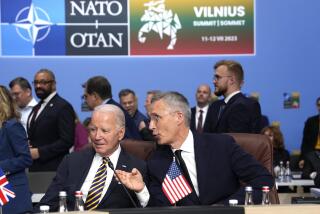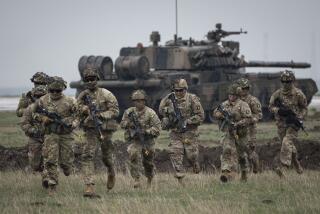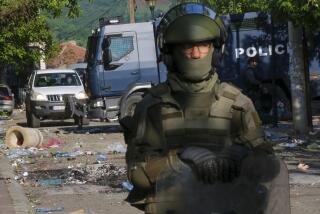Serbs Leave Key Peak as NATO OKs Attack Plan : Bosnia: Withdrawal from 2nd mountain is delayed. U.N. secretary general must approve allied air strikes.
- Share via
ZAGREB, Croatia — Striking their flag and abandoning high ground they risked their lives to grab, Bosnian Serb fighters quit a mountain near Sarajevo on Monday, U.N. officials said. But the Serbs stayed on a second, more strategic peak as NATO officials approved plans for air strikes against them if the siege of Bosnia’s capital does not end.
“The Serb flag is down from (Mt.) Bjelasnica, and there is no sign of Serb troops in the immediate vicinity,” Cmdr. Barry Frewer, U.N. spokesman for military operations in Sarajevo, announced as reports from the field came in.
When asked whether there were still Serbian tanks and artillery on the more distant, but higher, Mt. Igman, Frewer said, “They have not moved from Igman.” He said that withdrawal is expected to take several days.
The Serbian retreat, promised last week, began Monday as NATO ambassadors in Brussels, prodded by the United States, moved the alliance closer to its first military action since the organization was founded 44 years ago.
Officials of the North Atlantic Treaty Organization said that only another ambassadorial meeting and the approval of U.N. Secretary General Boutros Boutros-Ghali are needed before allied warplanes are launched.
“NATO is ready to act,” said NATO Secretary General Manfred Woerner after Monday’s special meeting of representatives from the 16 member nations.
He added that the final target options were being put together by NATO planners and would be executed by alliance aircraft based currently in Italy or on carriers in the Adriatic Sea.
Whether the air attacks are launched will depend on whether the Serbs lift their siege of the Bosnian capital, according to Woerner and U.S. Assistant Secretary of State Stephen Oxman. Such action--or inaction--will be subject to NATO’s “day-to-day review,” Woerner said.
NATO sources said that if air strikes are decided upon to reduce pressure on embattled Sarajevo--or its lines of humanitarian supply--no particular Serbian action will be needed to provoke the strikes. “We will simply tell the Serbians, enough is enough,” one senior official said.
In its communique, NATO declared that it is “essential” that the Bosnian Serbs place the heights around Sarajevo, and “means of access” to those heights, under the U.N. Protection Force, known as UNPROFOR.
On Sunday, the Serbs had said they would begin their pullout from Bjelasnica and Igman, which both lie southwest of Sarajevo, as promised last week if U.N. peacekeepers moved in to prevent troops from Bosnia’s Muslim-led government from retaking them.
About 150 French troops were sent on a U.N. mission along hazardous, mined routes to the twin peaks Monday, Frewer said. The mission was for reconnaissance and mine-clearing, he said.
But U.N. spokesman John Mills in Geneva said that U.N. patrols had “encountered obstacles” on Igman, including land mines and unidentified people who blocked their way. He gave no more details.
Igman is the more important mountain for Sarajevo’s beleaguered defenders, because it is a link on the last clandestine supply route for the city.
Before leaving for peace talks in Geneva himself, Bosnian Serb political leader Radovan Karadzic warned that “there will be more war” if the U.N. forces cannot keep the Bosnian Muslims from moving back onto the heights that the Serbs won from them last week.
There is conjecture that by insisting on a strong U.N. presence in the mountains, the Serbs hope to turn the peacekeepers into human shields to minimize chances for a NATO air strike. And even if the Serbs complete their withdrawal as promised, they will still dominate the high ground around Sarajevo.
Besides vowing to leave the two mountains, the Serbs also have pledged to open two routes into Sarajevo for civilians and aid convoys, and to restore electricity and water to the city--one of the few remaining pockets of Bosnian territory still controlled by government troops.
The Serbian withdrawal had been a condition for Bosnian President Alija Izetbegovic to return to the talks in Geneva, which are aimed at ending the fighting and partitioning Bosnia-Herzegovina into three ethnic zones. Izetbegovic returned to Geneva on Monday but did not meet with negotiators from the other warring factions.
The off-and-on talks in Geneva might act as a brake on military action, diplomats said, because negotiators Lord Owen and Thorvald Stoltenberg believe that air bombardments--or even the possibility of them--are keeping the Bosnian Muslim leaders from agreeing to a peace based on partition.
NATO officials would not specify publicly the exact targets allied warplanes would strike. One NATO planner said privately, however, that targets would include Serbian artillery positions ringing Sarajevo, ammunition dumps and local command posts.
NATO officers insisted there would be no strategic targets, such as population centers or power plants, nor would allied planes strike outside Bosnian boundaries. However, they agreed that targets would not be limited to defending Sarajevo and its surrounding heights.
The NATO meeting also confirmed that a knotty problem in the command structure involved in any action in Bosnia had been resolved. It was agreed Monday that although Boutros-Ghali is to decide on any NATO order for air strikes, virtual veto power may be given to the two senior U.N. officers in the Bosnia region: French Gen. Jean Cot and Belgian Gen. Francis Briquemont.
The Americans had previously insisted that NATO be the controlling factor in any military activity, since the United States has the major role in the organization.
In Washington, U.S. officials described Monday’s action in Brussels as “cocking the gun.” They said that NATO will call a second meeting as needed to give the go-ahead--or “pull the trigger”--for an actual strike. Officials said the allies might hit some Serbian-held artillery “as a warning shot” before launching any full-fledged air strikes.
U.S. officials said the NATO accord was purposely “vague” about what kinds of actions by the Serbs might trigger allied air strikes. But they said generally that the attacks almost certainly would be launched if the Serbs engaged in heavy shelling of Sarajevo, such as occurred two weeks ago, or cut off lifeline utilities such as fuel and water, or blocked further humanitarian relief efforts.
U.S. officials conceded that the Clinton Administration believes that the Serbs’ behavior in Bosnia now does not warrant any military action. But they warn that time for action is short, because Sarajevo is soon going to run out of food and supplies.
Dahlburg reported from Zagreb and Tuohy from Brussels. Staff writer Art Pine, in Washington, contributed to this story.
Stranglehold Eases
Serbian tanks and artillery were being pulled back from peaks around Sarajevo, a city of 350,000 that has been under siege for 16 months.
Mt. Igman: Serbian forces still in place. Government’s only known supply route.
Mt. Bjelasnica: U.N. confirms pullback from positions captured last week.
More to Read
Sign up for Essential California
The most important California stories and recommendations in your inbox every morning.
You may occasionally receive promotional content from the Los Angeles Times.









